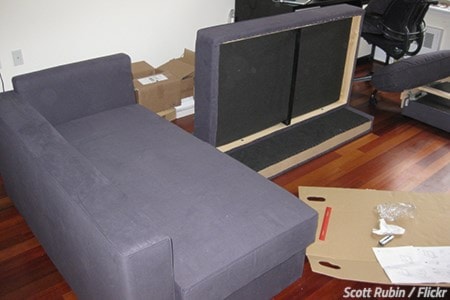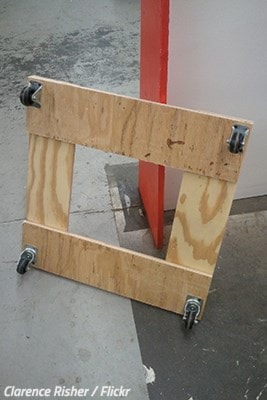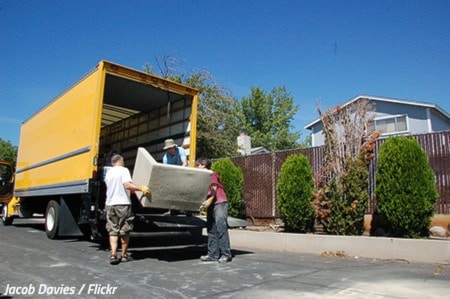
The Ultimate Guide to Moving a Couch By Yourself
by Nick, Digital Specialist | October 9, 2021
Moving a sofa by yourself can be a pain...here are some tricks for moving your sofa like the pros!
(editor's note: this article appears on the website mymovingreviews.com)
You don’t necessarily have to be considered a couch potato to love your couch so much that you can’t bear the thought of parting with your favorite piece of furniture when it’s time to move out again.
And even though materialism may not be your most favorite word in the world, your beloved sofa will accompany you to your new home no matter what. You and your loyal furniture friend will not be parted, end of discussion.
We have dedicated this complete guide to moving a couch by yourself the move related issues and problems you may have when trying to transport your dear couch from one home to another in a way that will guarantee the safety of your furniture piece and your property, and most importantly – your safety too.
1. Home Inventory: Should I move my couch at all? One of the most important things to remember when you’re getting ready to move to another house altogether is that it is (almost) never justified to first lose time to prepare for transportation and then waste money to relocate all of your earthly possessions between the two homes. Whether you realize it or not, a house move is an excellent opportunity to slim down the number of your belongings to the items you really want and the items that you will really need in the foreseeable future. And this unique opportunity comes in the form of the so-called house inventory checklist.
The idea behind a detailed home inventory is to actually see how much stuff you possess before it’s time to start packing it in moving boxes. In most cases, you’ll be faced with relatively easy choices (the things you must take with you on one hand, and the things that are not worth moving on the other). However, you should expect much tougher choices as well, especially when it comes to whether to relocate most of your furniture pieces, or not. Interestingly enough, the heavier, larger and bulkier a piece of furniture it, the tougher the decision seems to be.
If you happen to be wondering what to do with your couch just days before the actual relocation, there are a few questions that can help you make the right decision and never look back. After all, it’s your money, time, and nerves that are on the line here, so you want to reach the right decision about whether to move your couch by yourself, or not.
- How valuable is your couch? If your sofa 1) was made by a famous manufacturer, 2) is a dear gift from a person you care about, 3) is a priceless family heirloom, or 4) is already considered a piece of antique furniture, then you should definitely move it with you.
- What’s its current condition? The older and more worn out your trusted couch is, the easier it will be for you to just let it go and purchase a new one upon arrival at your new home. Again, the sentimental attachment you have to it will ultimately influence your decision one way or another.

2. How to protect a couch when moving
The moment you have decided to take your favorite piece of furniture with you is the exact moment you should think about how to prepare your sofa for moving. This preparation stage consists of two individual tasks which will ensure that your couch stays protected throughout the house move.
Stage 1: How to disassemble a couch for moving
Consider removing any detachable elements from your couch to make it not only easier and safer to transport, but also to prevent unexpected property damage if a protruding part accidentally hits a doorway or a corner. Here’s what to keep in mind before you take apart a couch for moving.
- If possible, remove the legs of your couch to eliminate a number of difficulties along the way. Sofa legs are most often screwed to the frame structure of your furniture piece, so all you need to do is use a suitable screwdriver to disengage them.
- In addition to the legs, remove all other parts that can be safely removed, such as armrests, cushions, covers, and so on. The idea is to leave your couch as stripped down as possible.
- Keep all screws and various other hardware elements you have removed in a plastic bag or a small metal container with a tight lid. Note that even the loss of a single fastening element could cause you to waste valuable time later on until you can find a replacement.
- If you’re not sure how to disassemble your couch, call up a friend who you know will be able to assist you, or contact a knowledgeable expert to avoid possible irreparable damage to your piece.
Stage 2: How to wrap a couch for moving
After the partial disassembly, it’s time to pack your couch to keep it perfectly protected all the way until it reaches its destination. Follow the steps below to keep your furniture out of harm’s way:
- First of all, use clean packing paper or bubble wrap to protect any elements you have just removed from your couch, and pack those parts in a separate cardboard box of the proper size. Label that box accordingly.
- If your sofa still has protruding parts which you haven’t removed for one reason or another, or very delicate pieces (usually ornaments) that are prone to damage, use bubble wrap to cover such fragile components, and tape the protective bubbly material in place with packing tape. Do not tape directly over the upholstery or polished wooden surfaces.
- If you’re moving a recliner sofa, then secure the metal mechanism with a furniture strap or a piece of rope to prevent it from opening accidentally during transportation.
- If your couch is extremely valuable (for example, an antique piece of furniture) or is not an antique but cost you a fortune nonetheless, you will want to add another level of protection by covering it up in shrink wrap – the ultimate protective material against moisture, dirt, and dust.
- For extra protection of the corners of your couch, which are naturally rather susceptible to accidental hits, you are advised to tape pieces of thick cardboard of the adequate size and shape. This way, the corrugated cardboard will absorb the shock of undesirable external forces and will keep your furniture well protected.
- The next step is all about taking advantage of the unparalleled protection of moving blankets. Wrap the thick protective coverings around the entire length of your furniture piece and use packing tape to keep the whole bundle together. If you don’t have any furniture blankets (rentable or purchasable from any local moving company), then you’re free to use ordinary household blankets which, mind you, will have a much lesser degree of overall protection.

3. What equipment is needed for moving a large couch?
As soon as you know the best way to wrap a couch for moving – ready to be transported first to the moving vehicle and then to its final destination – it’s time to think about whether you actually have the proper equipment to complete the moving job by yourself.*
*Note that by yourself does not mean you can and will actually lift and carry your big and heavy couch entirely on your own. In fact, you should never try to be the hero of the day and attempt a Hercules-like feat. Moving a couch by yourself simply means that that pre-move task will be marked as complete without professional movers but through the invaluable assistance of loyal helpers, such as family members, friends /the usual suspects/, and ready-to-help neighbors who are not really any friends of yours.
There are three pieces of moving equipment you will need to get hold of prior to the couch moving operations:
- Furniture sliders. If your intended course of action is to slide your heavy couch across the room to the door, or maybe even through the door until the front door of your home, then you’re going to need furniture sliders. A furniture slider is nothing more than a piece of sturdy plastic with one side made of hard rubber to minimize the friction between the furniture and the floor. Place a slider under each couch leg, or couch corner if you’ve already removed the legs, and push /always push, don’t pull/ your big sofa towards the door. Yes, it’s that easy! You can purchase such furniture sliders from a local moving company or a home goods store.
- A furniture dolly. There isn’t a single reason why you shouldn’t take advantage of one of the greatest inventions in the history of mankind – the wheel. Rent a furniture dolly and the task of moving a big sofa will be so much easier and safer! Furniture dollies are 4-wheel square platforms that sit relatively low on the ground. Read on to learn the right steps of moving a couch with a dolly. Again, a local mover is your best bet to rent such a 4-wheeler dolly from. Keep in mind that a furniture dolly is different from a hand truck – the two-wheel L-shaped handcart that is used primarily for transporting boxes and super heavy household appliances, such as refrigerators, washing machines, stoves, and so on.
- Furniture straps. Moving straps can be used for transferring the weight of a furniture piece from your back to a much stronger muscle group, thus allowing you to lift and carry your large couch easier. However, if you have never used straps before, you are strongly advised to use a furniture dolly to move your couch out of your home and all the way to the moving van.

4. What are the best ways to move a couch? Insider safety tips for moving a couch!
It seems like you are now ready to move your 2-seater or 3-seater couch to your new house. Of course, the steps to moving a couch without professional movers will depend on the exact moving scenario ahead of you. If you look closely at the sofa moving methods below, as you should, you will notice that the common factor in all of them is… friends.
You must secure the help of good friends (or at least one friend if your sofa is neither too heavy nor too bulky) to make this while furniture relocation project work. If you can’t find any available friends, then your options will get rather limited, and you will most likely need to seek professional assistance. The thing is, Moving day is never just about moving one piece of furniture, is it?
Insider safety tips for moving a couch
- Your best bet is to assess each couch moving situation properly. Costly property damage and painful personal injuries are often a direct result of underestimating the difficulty of the current situation.
- Before you begin the relocation task, however, coordinate between yourselves communication and danger signals so that everyone is on the same page.
- If possible, assign a separate person whose primary job will be to walk ahead of you and shout out in case of impending danger.
- Walk the intended path out of your home and make sure it is clear of any obstacles that can jeopardize the entire operation.
- Keep small kids and pets away from the pre-determined path of moving out your heavy furniture pieces.
- Wear your most convenient and flexible clothes, and have closed anti-slip sole shoes for maximum protection of your feet.
- Depending on the exact weight and dimensions of your couch, preferably you will need 3 helpers besides you to get the job done quicker, easier, and safer.
Couch Moving Method 1: Friends + Lifting + Carrying
- For heavier and larger furniture pieces, have one person at each corner of your sofa, or at each section in the case of a big sectional sofa.
- It’s critical that you are familiar with and take advantage of the proper lifting techniques to prevent injuries when moving out.
- Haste makes waste! Walk slowly to have ample time to react if things turn for the worse.
- If you encounter a problem when fitting your sofa through a small doorway or a narrow corridor, read on to learn what you can do to solve that issue.
Couch Moving Method 2: Friends + Sliders + Lifting + Carrying
- Instead of lifting and carrying a heavy couch across the room to the doorway, a great option is to use the sliding convenience of furniture sliders. Why lift and carry when you can slide?
- There are sliders that work best on carpeted floors, and such that work great on hardwood floors. Be sure to purchase or rent the right type of furniture sliders for your home.
- Using sliders is easy – you simply lift each corner or leg of your oversized couch, position a slider underneath with the smooth edge facing the floor, and push the single piece of furniture towards the door. Do this slowly and push from the lower section of your sofa, not from its top, to prevent tip-overs.
Couch Moving Method 3: Friends + Lifting + Furniture dolly
- If you wish to keep a couch from moving on hardwood floors, then a very good option is to use a furniture dolly to transport your sofa to the waiting moving truck. The soft rubber wheels are surely floor-friendly, but exactly how to move a sofa with a dolly?
- Get the furniture dolly as close to the couch as you can. Use all the manpower you have to lift the furniture piece off the ground, and then either position it directly onto the 4-wheeler, or have a person slide the dolly underneath your piece. Either way, place your couch in the very center of the dolly.
- If the furniture dolly doesn’t seem too clean, then place a clean blanket first before you load your sofa on it.
- This step is vital – you need to stabilize the couch onto the furniture dolly so that it won’t move during the trip to the truck. Use straps or pieces of rope to immobilize it completely, and thus avoid moving day accidents. As an extra precaution, use any free hands to hold the couch when it’s being moved around.
- How to move a sofa upstairs or downstairs? Furniture dollies are not designed to go upstairs or downstairs, so your viable options are to carry the furniture piece by hand if its weight, size, and shape allow it, to use the elevator, or seek professional assistance if nothing else works out for you.
Couch Moving Method 4: Friends + Moving van + Loading
If you’ve reached the moving vehicle safely, then you’ve done a great job! Now it’s time to learn how to load a sofa on a moving truck.
- Before you get your favorite couch into the moving van, you will actually need a moving vehicle in the first place, right? Refer to our Guide on Rental Trucks to get a good idea of what size of van you need to move your sofa. The decision will depend on several factors, most importantly on the size of your home and the items you have in it.
- Loading your couch into the back of the moving truck is a pretty straightforward task with one exception – the short trip along the loading ramp. Check to make sure that the loading ramp is clean, dry, and free of obstacles.
- As a rule of thumb, large furniture pieces should be loaded after all the moving boxes. When you’re going up the ramp, either carrying your faithful couch or having it strapped down onto a furniture dolly, proceed with great caution as that is the moment when bad accidents can happen in the blink of an eye. Go as slowly as possible and think each step before you take it.
- Once again, the task of immobilizing your couch for the relocation journey ahead becomes vital for the safety of your operation. Use straps or rope to tie the loaded sofa to the side of the truck and make sure no other household items come or can come into contact with it and damage your piece during the trip.

5. How to move a couch into a small doorway?
In most cases, moving a couch by yourself should not present any insurmountable difficulties. Good planning and friendly help tend to contribute greatly to a smooth couch moving experience. However, unless you’re being careful and proactive, an unexpected problem could slow down or even temporarily halt your relocation inertia – finding out a little too late that your couch won’t fit through a smaller door or through a narrow corridor.
Luckily, there are a few good ways to prevent such an unfortunate incident from happening, and even a few techniques to save yourself from trouble if a bottleneck situation is already a fact. The first preventative measure is to measure your couch.
How to measure a couch for moving? It’s very easy:
- just use a measuring tape and note down the height, width, and length of your furniture piece.
- Then, measure the dimensions of all the openings along the intended path out of your home – doorways, corridors, staircases, elevator doors, or even tight corners.
- Compare the two measurements and see where, if at all, you might have a problem.
- Usually a quick look at the digits will reveal whether you will have any difficulties moving the couch through a door or not.
- And if there’s nothing but bad news ahead, then use one of the methods below to get out of trouble.
- Try out different angles to get your sofa through tight openings. You’ll probably be surprised to witness how even a slight change of an approaching angle can turn things in your favor.
- Take advantage of the soft upholstery of your couch to squeeze it through slightly smaller doorways or tighter corners. Sometimes you’ll need to provide no more than a few inches of extra space so that the couch can pass through safely.
- If the two transportation techniques above won’t work, then it’s time to remove any detachable parts of your couch as explained in detail earlier. Moving a couch around a corner will be so much easier if the legs of the furniture piece are removed beforehand. The same goes for other protruding elements as well.
- When things get tight around a doorway, an extra inch or two can make a big difference. If possible, consider removing the problematic door off its hinges to provide that tiny additional room for safe passage.
- If nothing works and all your careful planning yields nothing but frustration, then it’s time to admit to yourself that you won’t manage to move that couch of yours out of your home, and then call in the pros. Hoisting of super big and oddly shaped furniture pieces is a service offered by some moving companies, so that is also a viable option for you.

6. How to find the best furniture movers
Want to know the easiest way to move a heavy couch? Just pay someone to move your couch as it doesn’t get any easier than that. And that someone would better have extensive experience in moving heavy and large furniture! After all, you wouldn’t want to see one of your most favorite pieces of furniture damaged.
Professional assistance sounds great, but how much does it cost to move? As a rule, the cost of moving a couch will be included in the moving estimate you will receive for the entire move. You won’t be moving just your sofa bed, will you? The chances are that you’re also taking more pieces of furniture and various other household items as well. As the price of each residential move is calculated on a case-by-case basis, all you need to do is request free moving quotes from moving companies that are trustworthy and reliable to do that job.

BROWSE BY TAG:
ALL CATEGORIES:
MOST POPULAR:
MOST RECENT:





